CGT, Small Business Concessions and Case Study of Julie in Australia
VerifiedAdded on 2019/11/08
|7
|1518
|148
Report
AI Summary
This report provides a detailed analysis of Capital Gains Tax (CGT) in Australia, focusing on the introduction of CGT, its evolution, and the relevant legislation, particularly Section 104-5 of the Income Tax Assessment Act of 1997. The report explores the CGT events and exemptions, alongside the small business concessions (SBE) as defined by the Australian Fair Work Act of 2009. It examines the criteria for classifying an entity as an SBE, including employee count, net profit, annual turnover, and value of CGT assets. The report then delves into specific SBE concessions such as the 15-year exemption, 50% active asset reduction, retirement exemption, and rollover, illustrating their application through a case study of Julie, a suit-making business owner. The conclusion highlights the tax implications for Julie, demonstrating the application of the rollover concession and its impact on her CGT liability, emphasizing the practical application of tax laws and concessions for small business owners. The report references several sources to support the analysis.
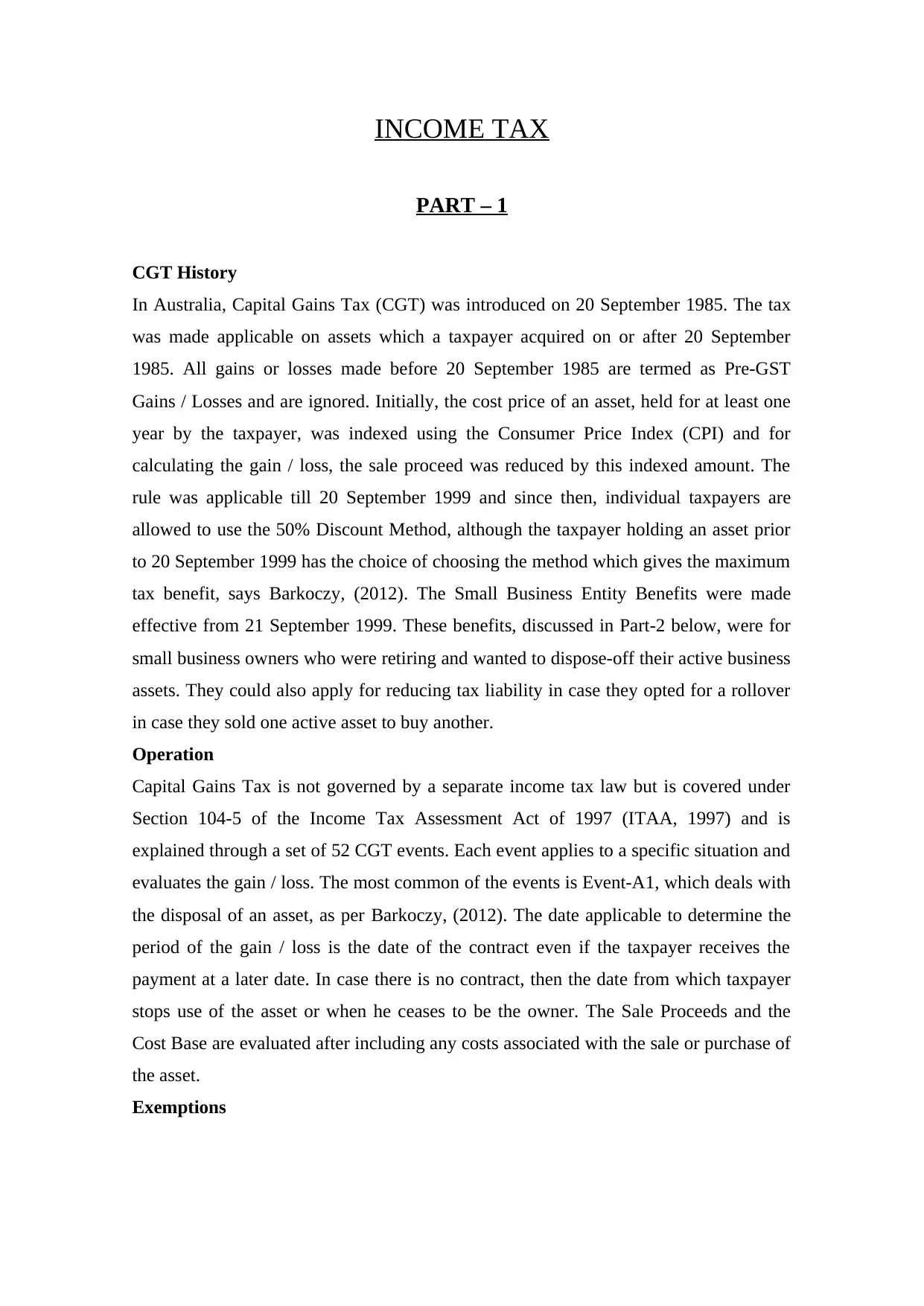
INCOME TAX
PART – 1
CGT History
In Australia, Capital Gains Tax (CGT) was introduced on 20 September 1985. The tax
was made applicable on assets which a taxpayer acquired on or after 20 September
1985. All gains or losses made before 20 September 1985 are termed as Pre-GST
Gains / Losses and are ignored. Initially, the cost price of an asset, held for at least one
year by the taxpayer, was indexed using the Consumer Price Index (CPI) and for
calculating the gain / loss, the sale proceed was reduced by this indexed amount. The
rule was applicable till 20 September 1999 and since then, individual taxpayers are
allowed to use the 50% Discount Method, although the taxpayer holding an asset prior
to 20 September 1999 has the choice of choosing the method which gives the maximum
tax benefit, says Barkoczy, (2012). The Small Business Entity Benefits were made
effective from 21 September 1999. These benefits, discussed in Part-2 below, were for
small business owners who were retiring and wanted to dispose-off their active business
assets. They could also apply for reducing tax liability in case they opted for a rollover
in case they sold one active asset to buy another.
Operation
Capital Gains Tax is not governed by a separate income tax law but is covered under
Section 104-5 of the Income Tax Assessment Act of 1997 (ITAA, 1997) and is
explained through a set of 52 CGT events. Each event applies to a specific situation and
evaluates the gain / loss. The most common of the events is Event-A1, which deals with
the disposal of an asset, as per Barkoczy, (2012). The date applicable to determine the
period of the gain / loss is the date of the contract even if the taxpayer receives the
payment at a later date. In case there is no contract, then the date from which taxpayer
stops use of the asset or when he ceases to be the owner. The Sale Proceeds and the
Cost Base are evaluated after including any costs associated with the sale or purchase of
the asset.
Exemptions
PART – 1
CGT History
In Australia, Capital Gains Tax (CGT) was introduced on 20 September 1985. The tax
was made applicable on assets which a taxpayer acquired on or after 20 September
1985. All gains or losses made before 20 September 1985 are termed as Pre-GST
Gains / Losses and are ignored. Initially, the cost price of an asset, held for at least one
year by the taxpayer, was indexed using the Consumer Price Index (CPI) and for
calculating the gain / loss, the sale proceed was reduced by this indexed amount. The
rule was applicable till 20 September 1999 and since then, individual taxpayers are
allowed to use the 50% Discount Method, although the taxpayer holding an asset prior
to 20 September 1999 has the choice of choosing the method which gives the maximum
tax benefit, says Barkoczy, (2012). The Small Business Entity Benefits were made
effective from 21 September 1999. These benefits, discussed in Part-2 below, were for
small business owners who were retiring and wanted to dispose-off their active business
assets. They could also apply for reducing tax liability in case they opted for a rollover
in case they sold one active asset to buy another.
Operation
Capital Gains Tax is not governed by a separate income tax law but is covered under
Section 104-5 of the Income Tax Assessment Act of 1997 (ITAA, 1997) and is
explained through a set of 52 CGT events. Each event applies to a specific situation and
evaluates the gain / loss. The most common of the events is Event-A1, which deals with
the disposal of an asset, as per Barkoczy, (2012). The date applicable to determine the
period of the gain / loss is the date of the contract even if the taxpayer receives the
payment at a later date. In case there is no contract, then the date from which taxpayer
stops use of the asset or when he ceases to be the owner. The Sale Proceeds and the
Cost Base are evaluated after including any costs associated with the sale or purchase of
the asset.
Exemptions
Paraphrase This Document
Need a fresh take? Get an instant paraphrase of this document with our AI Paraphraser
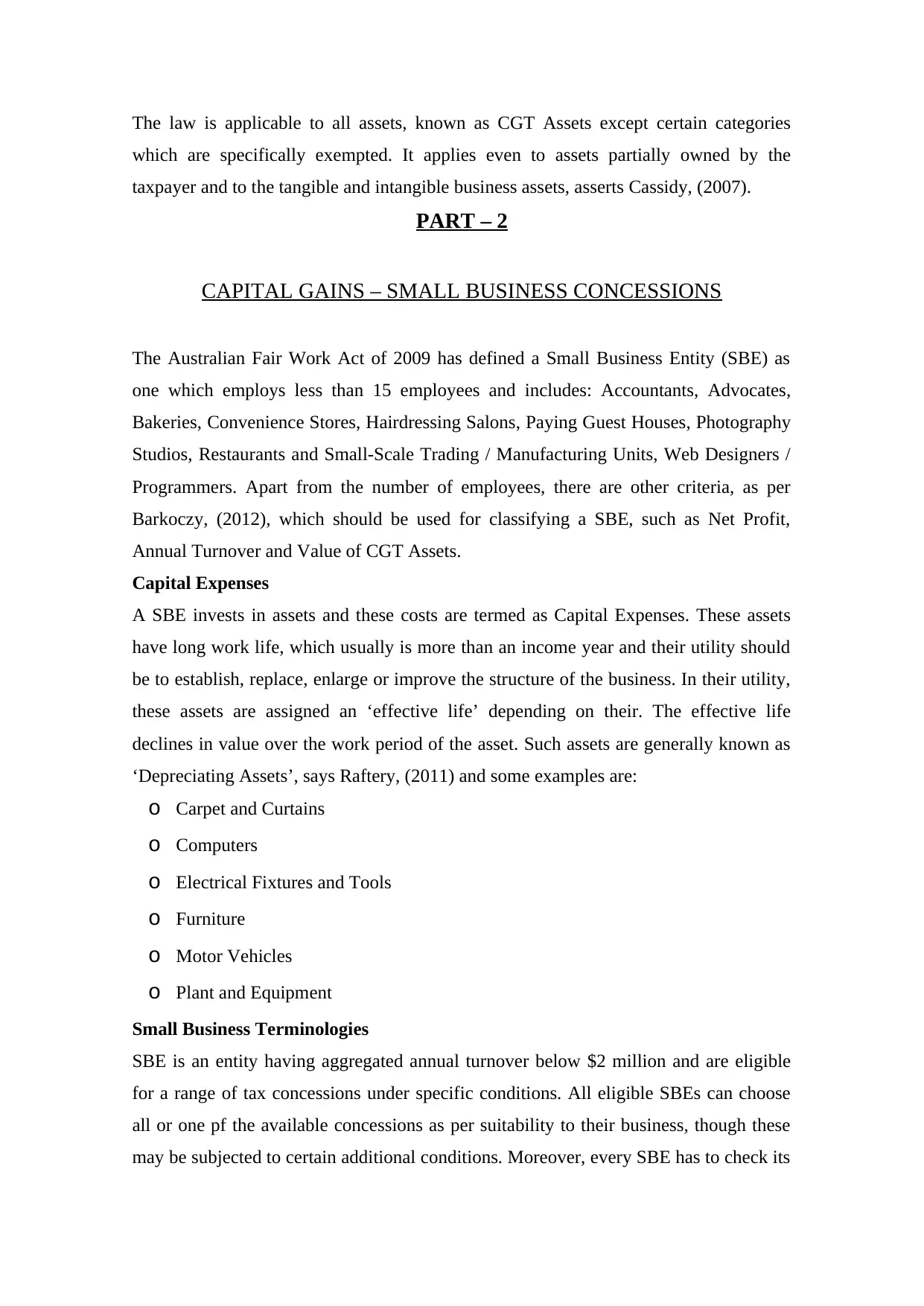
The law is applicable to all assets, known as CGT Assets except certain categories
which are specifically exempted. It applies even to assets partially owned by the
taxpayer and to the tangible and intangible business assets, asserts Cassidy, (2007).
PART – 2
CAPITAL GAINS – SMALL BUSINESS CONCESSIONS
The Australian Fair Work Act of 2009 has defined a Small Business Entity (SBE) as
one which employs less than 15 employees and includes: Accountants, Advocates,
Bakeries, Convenience Stores, Hairdressing Salons, Paying Guest Houses, Photography
Studios, Restaurants and Small-Scale Trading / Manufacturing Units, Web Designers /
Programmers. Apart from the number of employees, there are other criteria, as per
Barkoczy, (2012), which should be used for classifying a SBE, such as Net Profit,
Annual Turnover and Value of CGT Assets.
Capital Expenses
A SBE invests in assets and these costs are termed as Capital Expenses. These assets
have long work life, which usually is more than an income year and their utility should
be to establish, replace, enlarge or improve the structure of the business. In their utility,
these assets are assigned an ‘effective life’ depending on their. The effective life
declines in value over the work period of the asset. Such assets are generally known as
‘Depreciating Assets’, says Raftery, (2011) and some examples are:
o Carpet and Curtains
o Computers
o Electrical Fixtures and Tools
o Furniture
o Motor Vehicles
o Plant and Equipment
Small Business Terminologies
SBE is an entity having aggregated annual turnover below $2 million and are eligible
for a range of tax concessions under specific conditions. All eligible SBEs can choose
all or one pf the available concessions as per suitability to their business, though these
may be subjected to certain additional conditions. Moreover, every SBE has to check its
which are specifically exempted. It applies even to assets partially owned by the
taxpayer and to the tangible and intangible business assets, asserts Cassidy, (2007).
PART – 2
CAPITAL GAINS – SMALL BUSINESS CONCESSIONS
The Australian Fair Work Act of 2009 has defined a Small Business Entity (SBE) as
one which employs less than 15 employees and includes: Accountants, Advocates,
Bakeries, Convenience Stores, Hairdressing Salons, Paying Guest Houses, Photography
Studios, Restaurants and Small-Scale Trading / Manufacturing Units, Web Designers /
Programmers. Apart from the number of employees, there are other criteria, as per
Barkoczy, (2012), which should be used for classifying a SBE, such as Net Profit,
Annual Turnover and Value of CGT Assets.
Capital Expenses
A SBE invests in assets and these costs are termed as Capital Expenses. These assets
have long work life, which usually is more than an income year and their utility should
be to establish, replace, enlarge or improve the structure of the business. In their utility,
these assets are assigned an ‘effective life’ depending on their. The effective life
declines in value over the work period of the asset. Such assets are generally known as
‘Depreciating Assets’, says Raftery, (2011) and some examples are:
o Carpet and Curtains
o Computers
o Electrical Fixtures and Tools
o Furniture
o Motor Vehicles
o Plant and Equipment
Small Business Terminologies
SBE is an entity having aggregated annual turnover below $2 million and are eligible
for a range of tax concessions under specific conditions. All eligible SBEs can choose
all or one pf the available concessions as per suitability to their business, though these
may be subjected to certain additional conditions. Moreover, every SBE has to check its
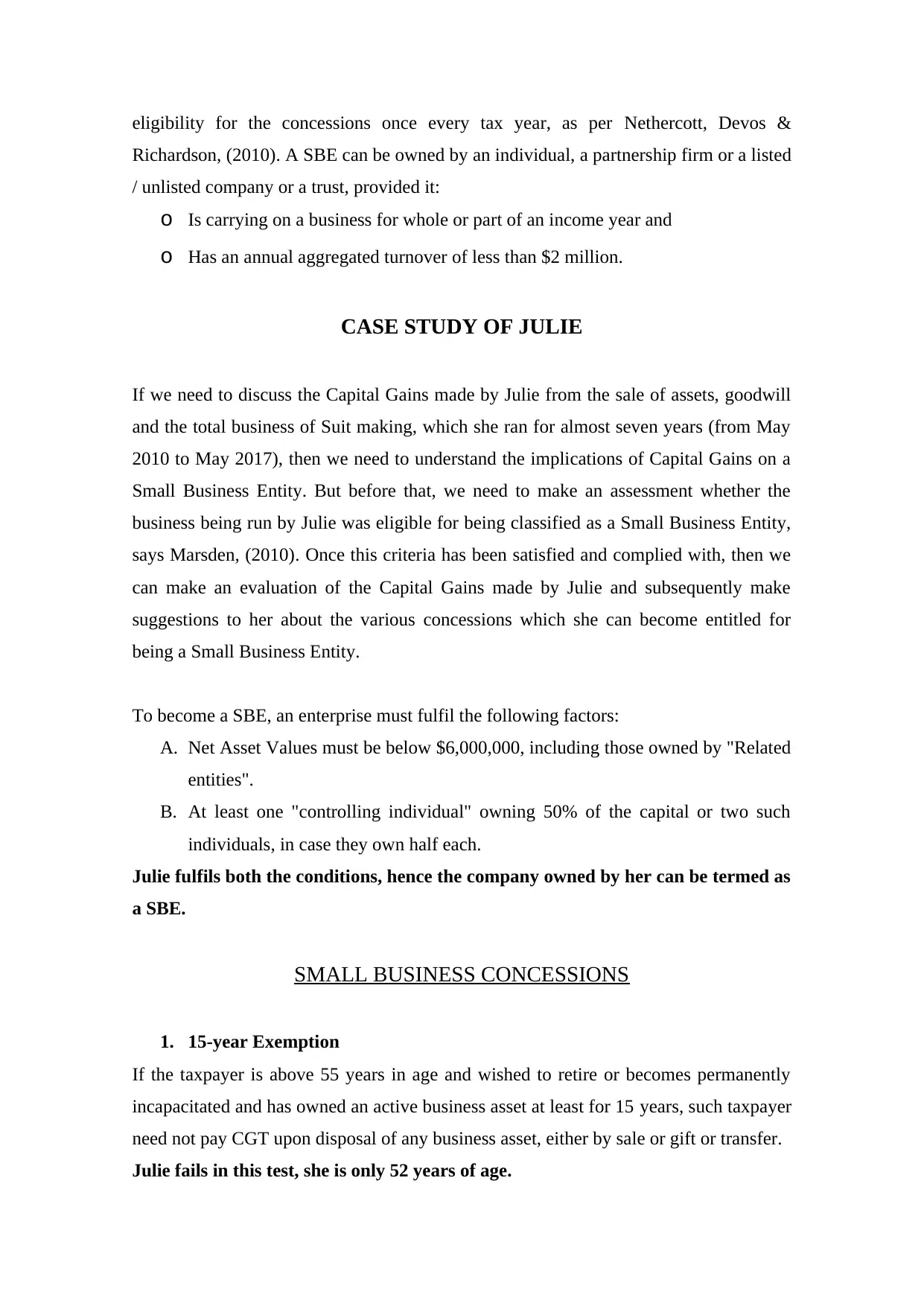
eligibility for the concessions once every tax year, as per Nethercott, Devos &
Richardson, (2010). A SBE can be owned by an individual, a partnership firm or a listed
/ unlisted company or a trust, provided it:
o Is carrying on a business for whole or part of an income year and
o Has an annual aggregated turnover of less than $2 million.
CASE STUDY OF JULIE
If we need to discuss the Capital Gains made by Julie from the sale of assets, goodwill
and the total business of Suit making, which she ran for almost seven years (from May
2010 to May 2017), then we need to understand the implications of Capital Gains on a
Small Business Entity. But before that, we need to make an assessment whether the
business being run by Julie was eligible for being classified as a Small Business Entity,
says Marsden, (2010). Once this criteria has been satisfied and complied with, then we
can make an evaluation of the Capital Gains made by Julie and subsequently make
suggestions to her about the various concessions which she can become entitled for
being a Small Business Entity.
To become a SBE, an enterprise must fulfil the following factors:
A. Net Asset Values must be below $6,000,000, including those owned by "Related
entities".
B. At least one "controlling individual" owning 50% of the capital or two such
individuals, in case they own half each.
Julie fulfils both the conditions, hence the company owned by her can be termed as
a SBE.
SMALL BUSINESS CONCESSIONS
1. 15-year Exemption
If the taxpayer is above 55 years in age and wished to retire or becomes permanently
incapacitated and has owned an active business asset at least for 15 years, such taxpayer
need not pay CGT upon disposal of any business asset, either by sale or gift or transfer.
Julie fails in this test, she is only 52 years of age.
Richardson, (2010). A SBE can be owned by an individual, a partnership firm or a listed
/ unlisted company or a trust, provided it:
o Is carrying on a business for whole or part of an income year and
o Has an annual aggregated turnover of less than $2 million.
CASE STUDY OF JULIE
If we need to discuss the Capital Gains made by Julie from the sale of assets, goodwill
and the total business of Suit making, which she ran for almost seven years (from May
2010 to May 2017), then we need to understand the implications of Capital Gains on a
Small Business Entity. But before that, we need to make an assessment whether the
business being run by Julie was eligible for being classified as a Small Business Entity,
says Marsden, (2010). Once this criteria has been satisfied and complied with, then we
can make an evaluation of the Capital Gains made by Julie and subsequently make
suggestions to her about the various concessions which she can become entitled for
being a Small Business Entity.
To become a SBE, an enterprise must fulfil the following factors:
A. Net Asset Values must be below $6,000,000, including those owned by "Related
entities".
B. At least one "controlling individual" owning 50% of the capital or two such
individuals, in case they own half each.
Julie fulfils both the conditions, hence the company owned by her can be termed as
a SBE.
SMALL BUSINESS CONCESSIONS
1. 15-year Exemption
If the taxpayer is above 55 years in age and wished to retire or becomes permanently
incapacitated and has owned an active business asset at least for 15 years, such taxpayer
need not pay CGT upon disposal of any business asset, either by sale or gift or transfer.
Julie fails in this test, she is only 52 years of age.
⊘ This is a preview!⊘
Do you want full access?
Subscribe today to unlock all pages.

Trusted by 1+ million students worldwide
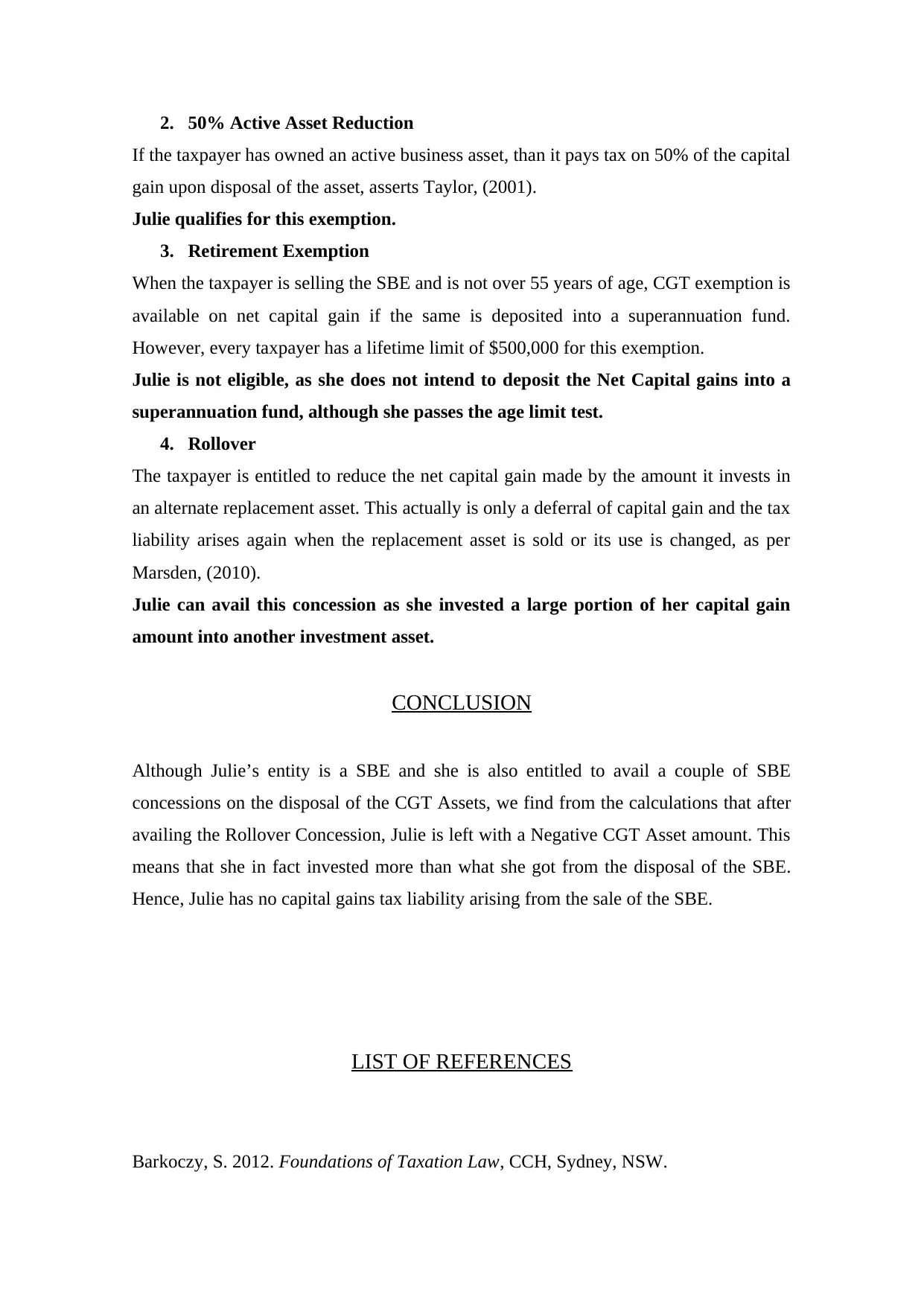
2. 50% Active Asset Reduction
If the taxpayer has owned an active business asset, than it pays tax on 50% of the capital
gain upon disposal of the asset, asserts Taylor, (2001).
Julie qualifies for this exemption.
3. Retirement Exemption
When the taxpayer is selling the SBE and is not over 55 years of age, CGT exemption is
available on net capital gain if the same is deposited into a superannuation fund.
However, every taxpayer has a lifetime limit of $500,000 for this exemption.
Julie is not eligible, as she does not intend to deposit the Net Capital gains into a
superannuation fund, although she passes the age limit test.
4. Rollover
The taxpayer is entitled to reduce the net capital gain made by the amount it invests in
an alternate replacement asset. This actually is only a deferral of capital gain and the tax
liability arises again when the replacement asset is sold or its use is changed, as per
Marsden, (2010).
Julie can avail this concession as she invested a large portion of her capital gain
amount into another investment asset.
CONCLUSION
Although Julie’s entity is a SBE and she is also entitled to avail a couple of SBE
concessions on the disposal of the CGT Assets, we find from the calculations that after
availing the Rollover Concession, Julie is left with a Negative CGT Asset amount. This
means that she in fact invested more than what she got from the disposal of the SBE.
Hence, Julie has no capital gains tax liability arising from the sale of the SBE.
LIST OF REFERENCES
Barkoczy, S. 2012. Foundations of Taxation Law, CCH, Sydney, NSW.
If the taxpayer has owned an active business asset, than it pays tax on 50% of the capital
gain upon disposal of the asset, asserts Taylor, (2001).
Julie qualifies for this exemption.
3. Retirement Exemption
When the taxpayer is selling the SBE and is not over 55 years of age, CGT exemption is
available on net capital gain if the same is deposited into a superannuation fund.
However, every taxpayer has a lifetime limit of $500,000 for this exemption.
Julie is not eligible, as she does not intend to deposit the Net Capital gains into a
superannuation fund, although she passes the age limit test.
4. Rollover
The taxpayer is entitled to reduce the net capital gain made by the amount it invests in
an alternate replacement asset. This actually is only a deferral of capital gain and the tax
liability arises again when the replacement asset is sold or its use is changed, as per
Marsden, (2010).
Julie can avail this concession as she invested a large portion of her capital gain
amount into another investment asset.
CONCLUSION
Although Julie’s entity is a SBE and she is also entitled to avail a couple of SBE
concessions on the disposal of the CGT Assets, we find from the calculations that after
availing the Rollover Concession, Julie is left with a Negative CGT Asset amount. This
means that she in fact invested more than what she got from the disposal of the SBE.
Hence, Julie has no capital gains tax liability arising from the sale of the SBE.
LIST OF REFERENCES
Barkoczy, S. 2012. Foundations of Taxation Law, CCH, Sydney, NSW.
Paraphrase This Document
Need a fresh take? Get an instant paraphrase of this document with our AI Paraphraser
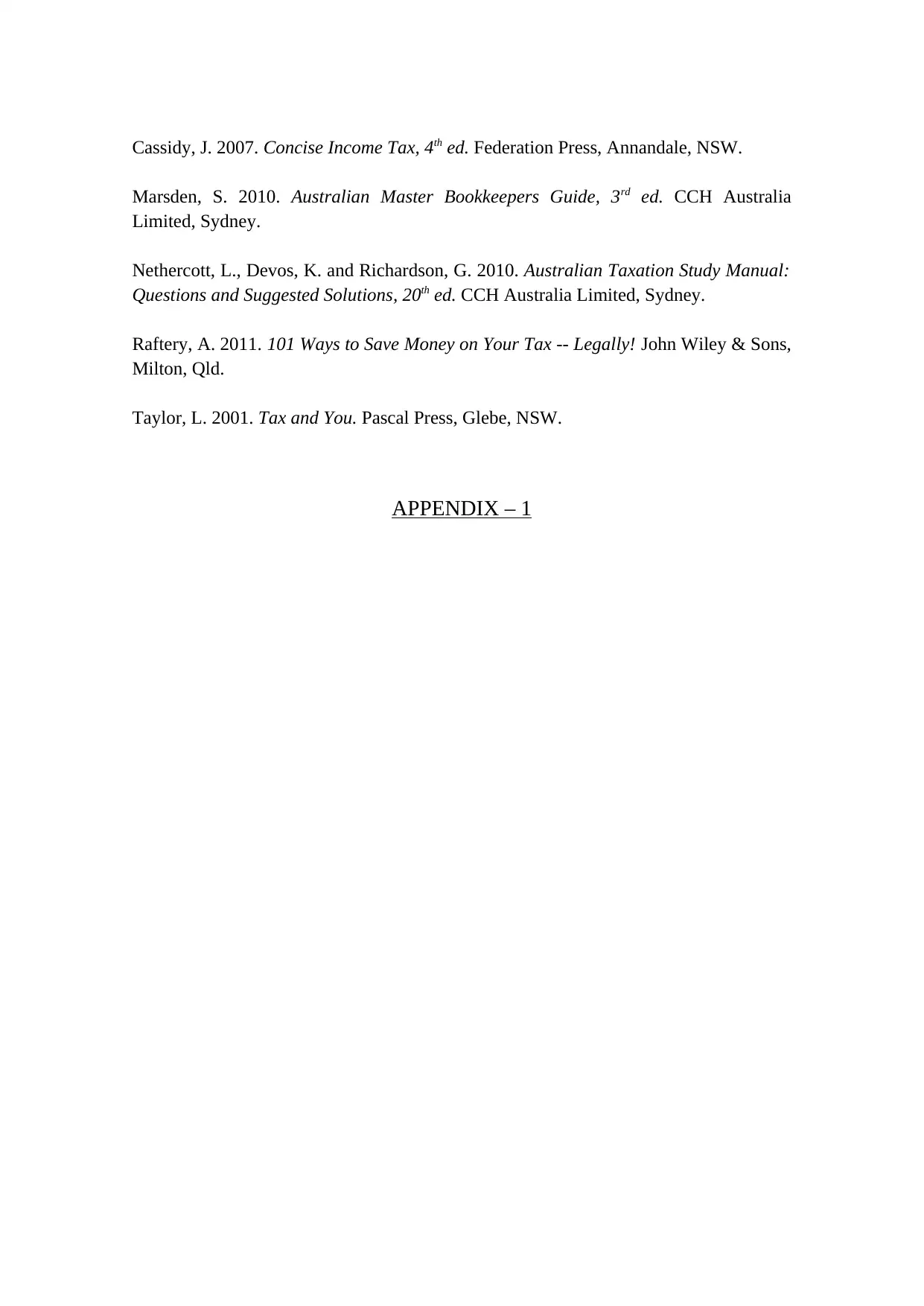
Cassidy, J. 2007. Concise Income Tax, 4th ed. Federation Press, Annandale, NSW.
Marsden, S. 2010. Australian Master Bookkeepers Guide, 3rd ed. CCH Australia
Limited, Sydney.
Nethercott, L., Devos, K. and Richardson, G. 2010. Australian Taxation Study Manual:
Questions and Suggested Solutions, 20th ed. CCH Australia Limited, Sydney.
Raftery, A. 2011. 101 Ways to Save Money on Your Tax -- Legally! John Wiley & Sons,
Milton, Qld.
Taylor, L. 2001. Tax and You. Pascal Press, Glebe, NSW.
APPENDIX – 1
Marsden, S. 2010. Australian Master Bookkeepers Guide, 3rd ed. CCH Australia
Limited, Sydney.
Nethercott, L., Devos, K. and Richardson, G. 2010. Australian Taxation Study Manual:
Questions and Suggested Solutions, 20th ed. CCH Australia Limited, Sydney.
Raftery, A. 2011. 101 Ways to Save Money on Your Tax -- Legally! John Wiley & Sons,
Milton, Qld.
Taylor, L. 2001. Tax and You. Pascal Press, Glebe, NSW.
APPENDIX – 1
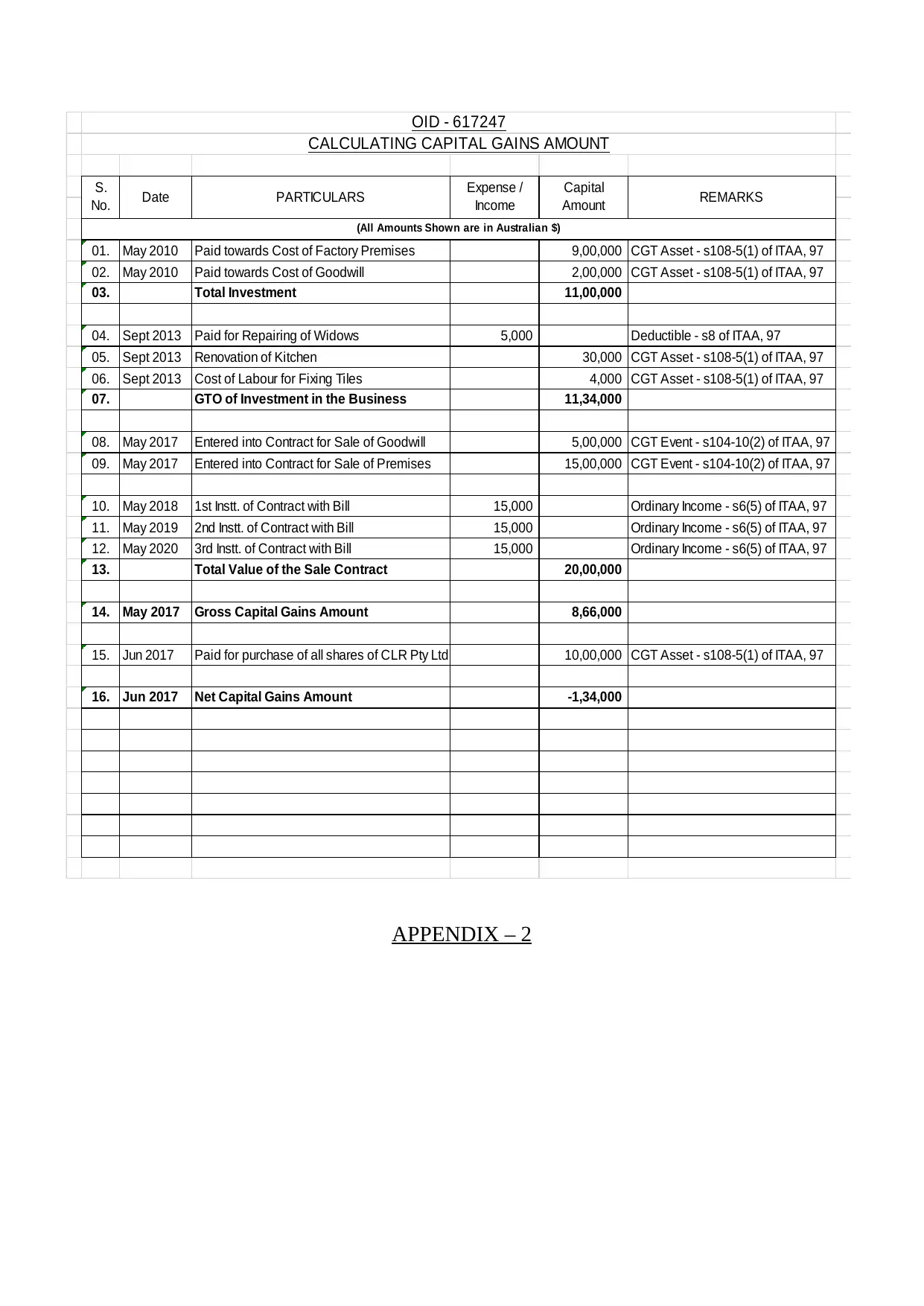
01. May 2010 Paid towards Cost of Factory Premises 9,00,000 CGT Asset - s108-5(1) of ITAA, 97
02. May 2010 Paid towards Cost of Goodwill 2,00,000 CGT Asset - s108-5(1) of ITAA, 97
03. Total Investment 11,00,000
04. Sept 2013 Paid for Repairing of Widows 5,000 Deductible - s8 of ITAA, 97
05. Sept 2013 Renovation of Kitchen 30,000 CGT Asset - s108-5(1) of ITAA, 97
06. Sept 2013 Cost of Labour for Fixing Tiles 4,000 CGT Asset - s108-5(1) of ITAA, 97
07. GTO of Investment in the Business 11,34,000
08. May 2017 Entered into Contract for Sale of Goodwill 5,00,000 CGT Event - s104-10(2) of ITAA, 97
09. May 2017 Entered into Contract for Sale of Premises 15,00,000 CGT Event - s104-10(2) of ITAA, 97
10. May 2018 1st Instt. of Contract with Bill 15,000 Ordinary Income - s6(5) of ITAA, 97
11. May 2019 2nd Instt. of Contract with Bill 15,000 Ordinary Income - s6(5) of ITAA, 97
12. May 2020 3rd Instt. of Contract with Bill 15,000 Ordinary Income - s6(5) of ITAA, 97
13. Total Value of the Sale Contract 20,00,000
14. May 2017 Gross Capital Gains Amount 8,66,000
15. Jun 2017 Paid for purchase of all shares of CLR Pty Ltd 10,00,000 CGT Asset - s108-5(1) of ITAA, 97
16. Jun 2017 Net Capital Gains Amount -1,34,000
OID - 617247
CALCULATING CAPITAL GAINS AMOUNT
Date
(All Amounts Shown are in Australian $)
S.
No. PARTICULARS Expense /
Income
Capital
Amount REMARKS
APPENDIX – 2
02. May 2010 Paid towards Cost of Goodwill 2,00,000 CGT Asset - s108-5(1) of ITAA, 97
03. Total Investment 11,00,000
04. Sept 2013 Paid for Repairing of Widows 5,000 Deductible - s8 of ITAA, 97
05. Sept 2013 Renovation of Kitchen 30,000 CGT Asset - s108-5(1) of ITAA, 97
06. Sept 2013 Cost of Labour for Fixing Tiles 4,000 CGT Asset - s108-5(1) of ITAA, 97
07. GTO of Investment in the Business 11,34,000
08. May 2017 Entered into Contract for Sale of Goodwill 5,00,000 CGT Event - s104-10(2) of ITAA, 97
09. May 2017 Entered into Contract for Sale of Premises 15,00,000 CGT Event - s104-10(2) of ITAA, 97
10. May 2018 1st Instt. of Contract with Bill 15,000 Ordinary Income - s6(5) of ITAA, 97
11. May 2019 2nd Instt. of Contract with Bill 15,000 Ordinary Income - s6(5) of ITAA, 97
12. May 2020 3rd Instt. of Contract with Bill 15,000 Ordinary Income - s6(5) of ITAA, 97
13. Total Value of the Sale Contract 20,00,000
14. May 2017 Gross Capital Gains Amount 8,66,000
15. Jun 2017 Paid for purchase of all shares of CLR Pty Ltd 10,00,000 CGT Asset - s108-5(1) of ITAA, 97
16. Jun 2017 Net Capital Gains Amount -1,34,000
OID - 617247
CALCULATING CAPITAL GAINS AMOUNT
Date
(All Amounts Shown are in Australian $)
S.
No. PARTICULARS Expense /
Income
Capital
Amount REMARKS
APPENDIX – 2
⊘ This is a preview!⊘
Do you want full access?
Subscribe today to unlock all pages.

Trusted by 1+ million students worldwide
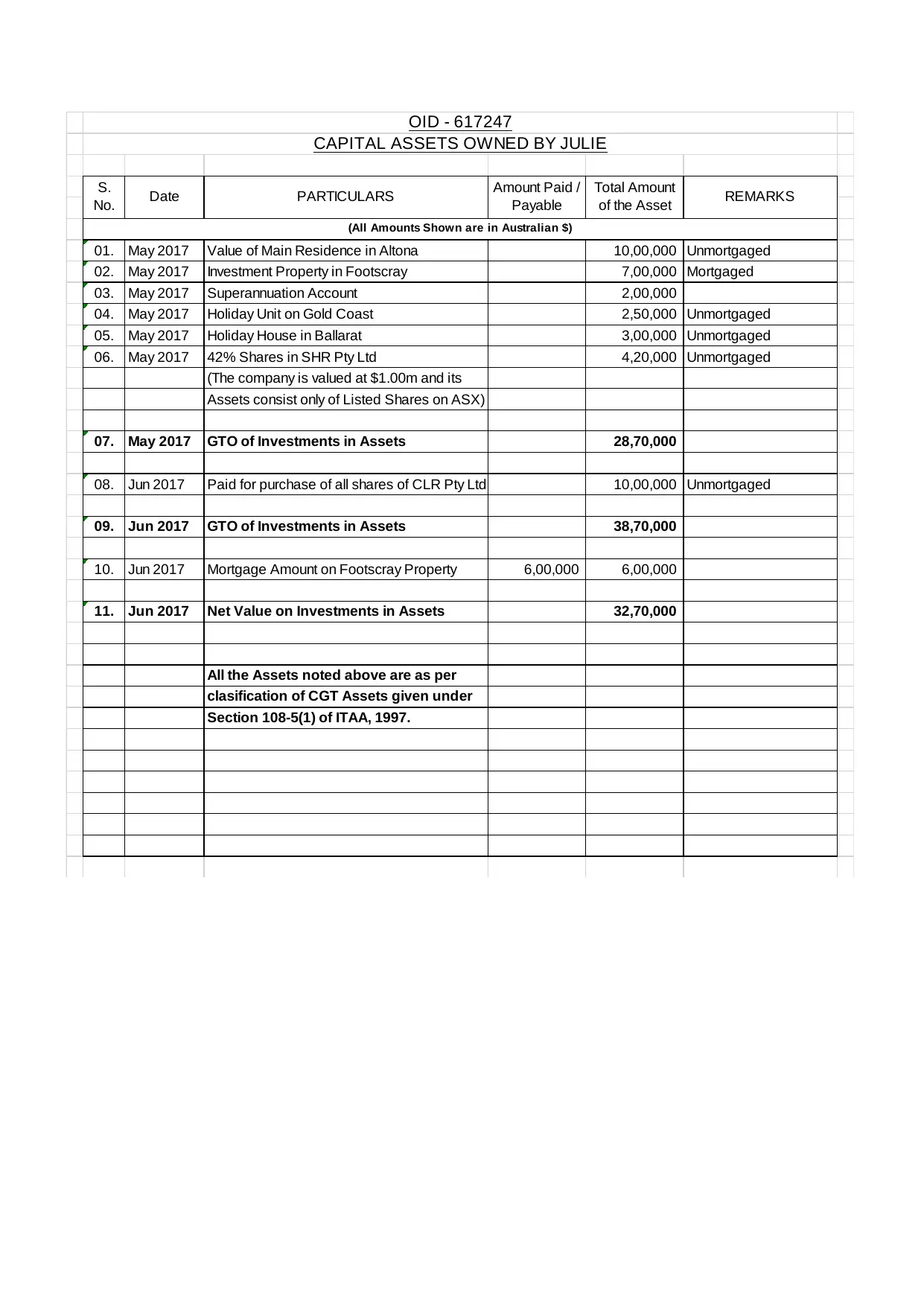
01. May 2017 Value of Main Residence in Altona 10,00,000 Unmortgaged
02. May 2017 Investment Property in Footscray 7,00,000 Mortgaged
03. May 2017 Superannuation Account 2,00,000
04. May 2017 Holiday Unit on Gold Coast 2,50,000 Unmortgaged
05. May 2017 Holiday House in Ballarat 3,00,000 Unmortgaged
06. May 2017 42% Shares in SHR Pty Ltd 4,20,000 Unmortgaged
(The company is valued at $1.00m and its
Assets consist only of Listed Shares on ASX)
07. May 2017 GTO of Investments in Assets 28,70,000
08. Jun 2017 Paid for purchase of all shares of CLR Pty Ltd 10,00,000 Unmortgaged
09. Jun 2017 GTO of Investments in Assets 38,70,000
10. Jun 2017 Mortgage Amount on Footscray Property 6,00,000 6,00,000
11. Jun 2017 Net Value on Investments in Assets 32,70,000
All the Assets noted above are as per
clasification of CGT Assets given under
Section 108-5(1) of ITAA, 1997.
(All Amounts Shown are in Australian $)
OID - 617247
CAPITAL ASSETS OWNED BY JULIE
S.
No. Date PARTICULARS Amount Paid /
Payable
Total Amount
of the Asset REMARKS
02. May 2017 Investment Property in Footscray 7,00,000 Mortgaged
03. May 2017 Superannuation Account 2,00,000
04. May 2017 Holiday Unit on Gold Coast 2,50,000 Unmortgaged
05. May 2017 Holiday House in Ballarat 3,00,000 Unmortgaged
06. May 2017 42% Shares in SHR Pty Ltd 4,20,000 Unmortgaged
(The company is valued at $1.00m and its
Assets consist only of Listed Shares on ASX)
07. May 2017 GTO of Investments in Assets 28,70,000
08. Jun 2017 Paid for purchase of all shares of CLR Pty Ltd 10,00,000 Unmortgaged
09. Jun 2017 GTO of Investments in Assets 38,70,000
10. Jun 2017 Mortgage Amount on Footscray Property 6,00,000 6,00,000
11. Jun 2017 Net Value on Investments in Assets 32,70,000
All the Assets noted above are as per
clasification of CGT Assets given under
Section 108-5(1) of ITAA, 1997.
(All Amounts Shown are in Australian $)
OID - 617247
CAPITAL ASSETS OWNED BY JULIE
S.
No. Date PARTICULARS Amount Paid /
Payable
Total Amount
of the Asset REMARKS
1 out of 7
Related Documents
Your All-in-One AI-Powered Toolkit for Academic Success.
+13062052269
info@desklib.com
Available 24*7 on WhatsApp / Email
![[object Object]](/_next/static/media/star-bottom.7253800d.svg)
Unlock your academic potential
Copyright © 2020–2025 A2Z Services. All Rights Reserved. Developed and managed by ZUCOL.




